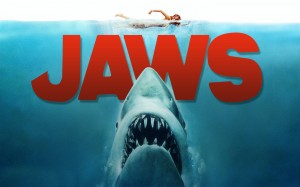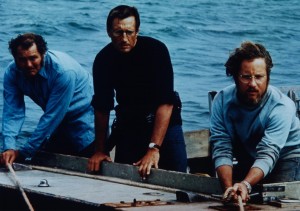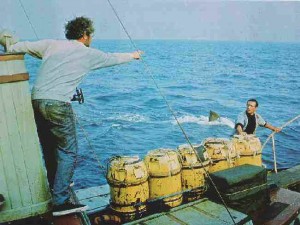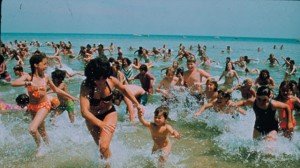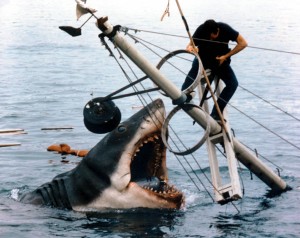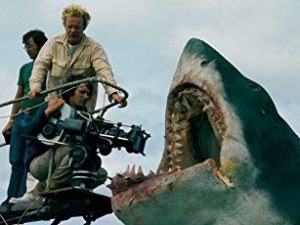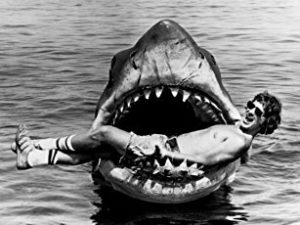Jaws ***** (1975, Roy Scheider, Richard Dreyfuss, Robert Shaw, Lorraine Gary, Murray Hamilton) – Classic Movie Review 526
The triple-Oscar-winning 1975 monster movie classic that propelled the 28-year-old director Steven Spielberg to the front rank of cinema story-tellers is a sleekly crafted rollercoaster ride of fear, suspense and thrills. Based on the bestselling novel by Peter Benchley, the story is compelling, in-your-face stuff. Unusually for a horror movie, Jaws was Oscar nominated as Best Picture.
Roy Scheider stars as Sheriff Martin Brody, the new local police chief at the idyllic-seeming New England seaside resort community of Amity Island. But the island is terrorised by an attack by a deadly great white shark, and Brody discovers the remains of a shark attack victim but is talked out of closing the beaches to swimmers by the villainous mayor Larry Vaughn (Murray Hamilton). But that weekend a boy is killed by the shark and his mother offers a bounty to kill the shark and Amity is swamped with hunters and fisherman.
So Sheriff Brody teams up with young oceanographer marine expert Matt Hooper (Richard Dreyfuss) and old seadog Quint (Robert Shaw) to combine their forces and fight back against the predator in their little boat. ‘We’re gonna need a bigger boat.’ Naturally, they get no help at all from the mayor, who’s too busy keeping the truth quiet from happy vacationers to do anything about the peril of the deep.
Apart from the very plastic-looking shark, the film is extremely skilfully made, with outstanding performances, plenty of pace, lots of well-placed shocks, a frightening climax and a famous eerie classic score by John Williams that won one of the film’s three 1976 Oscars for Best Original Score (along with Best Sound and Best Film Editing for Verna Fields).
Williams also won the Golden Globe for Best Original Score. The same awards year (1976), he won the Bafta for the forgotten score for The Towering Inferno.
None of the star cast was a first choice, but they are all absolutely ideal. More than that, they couldn’t be better.
Jaws was a box-office sensation, becoming the highest-grossing film ever, a record it held for two years until Star Wars.
Writer Benchley has a brief cameo as a TV reporter on the beach. Massachusetts’ Martha’s Vineyard is the real-life location for Amity Island. Spielberg calls the shark Bruce, his attorney’s name! The 130-minute TV version has several extra scenes.
Three sequels of diminishing quality followed: Jaws 2 (1978), Jaws III [Jaws 3D] (1983) and Jaws: The Revenge [Jaws 4] (1987), none of them directed by Spielberg or involved Benchley.
The 2000 25th Anniversary Edition features totally improved new sound effects, though the original won an Oscar for Best Sound (for Robert L Hoyt, Roger Heman Jr, Earl Madery and John R Carter). For this edition, Spielberg considered re-shooting the much-criticised scenes with the very plastic-looking shark, but finally decided against it.
The film led to some American public hysteria: a beach in Southern California was cleared by lifeguards due to sharks in the water, but they turned out to be dolphins; and in Florida, an immature pygmy sperm whale that beached itself was beaten to death by bystanders who mistook it for a shark.
Jaws the book was originally written as a comedy, well kind of. In 1971, amateur shark expert Peter Benchley met with Doubleday editor Thomas Congdon, who liked his idea for a novel about a shark terrorising a beach resort and offered him a $7,500 advance for the manuscript.
But Benchley only began writing once his agent warned him that if he did not deliver the pages, he would have to return the money he’d already cashed and spent. The hastily written pages were met with derision by Congdon, who disliked Benchley’s attempt at making the book comedic. Congdon approved only the first five pages, which went into the eventual book without any changes, but asked Benchley to follow the serious tone of the introduction. After a month, Benchley delivered rewritten chapters, which Congdon approved, with a broader outline of the story. The manuscript took a year and a half to complete.
Universal Pictures film producers Richard D Zanuck and David Brown heard about the book before publication and sought to film it. Benchley’s agent sold the rights for $150,000, plus $25,000 for Benchley to write the screenplay, pleasing the hard-up author, though it was a low figure, agreed before the book became a surprise bestseller.
Benchley wrote three script drafts before other writers took over, though the only other writer credited other than Benchley is the author of the shooting script, Carl Gottlieb, who appears in the film as Harry Meadows.
Sidney Sheinberg, the MCA/Universal executive who nurtured Steven Spielberg, died at 84 on 7 March 2019. Spielberg said: ‘He was the tallest, most stand-up guy I ever knew. He gave birth to my career and made Universal my home. He gave me Jaws, I gave him E. T. and he gave me Schindler’s List. We were a team for 25 years.’
John Williams celebrates his 90th birthday on 8 February 2022. He has 42 Oscar nominations and five wins: Fiddler on the Roof (1971), Jaws (1975), Star Wars (1977), E.T. The Extra-Terrestrial (1982), and Schindler’s List (1993). He is nominated again in 2020 for Star Wars: Episode IX – The Rise of Skywalker (2019) and in 2023 for The Fabelmans (2022).
Also in the cast are Lorraine Gary, Carl Gottlieb, Jeffrey Kramer, Susan Backlinie, Jonathan Filley, Ted Grossman, Chris Rebello, Jay Mello, Lee Fierro, Jeffrey Voorhees, Craig Kingsbury, Peter Benchley, Robert Nevin, Edward Chalmers Jr, Fritzi Jane Courtney, Cyprian R Dube, and Alfred Wilde.
The cinematographer is Bill Butler.
American cinematographer Bill Butler (April 7, 1921 – April 5, 2023) died in Los Angeles two days before his 102nd birthday. He is perhaps best known for his work on The Conversation (1974), Jaws (1975), and three Rocky sequels: Rocky II, Rocky III, and Rocky IV. He worked till Evil Angel in 2009.
Butler recalled: ‘I did some work with director Phil Kaufman on the Universal Studios lot as a writer while I was still trying to get into the Los Angeles camera guild. That’s when I met Steven Spielberg;. Butler then took charge of cinematography for two of Spielberg’s earliest films, Something Evil (1972) and Savage (1973). Later, Butler heard that Spielberg was preparing to shoot Jaws, mainly on Martha’s Vineyard in Massachusetts. ‘I said, “I hear you’re making a movie about a fish.”‘ After they joked awhile, Spielberg asked Butler if he was interested. Butler then spent most of his time on the picture in the water with Spielberg.
© Derek Winnert 2013 Classic Movie Review 526 derekwinnert.com
Check out more reviews on http://derekwinnert.com/

